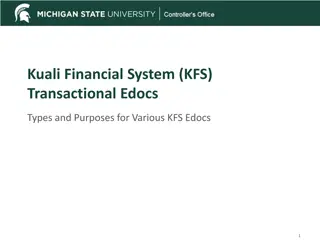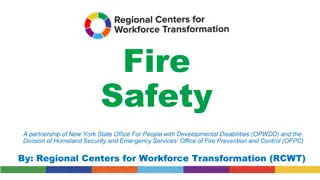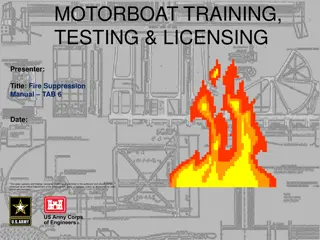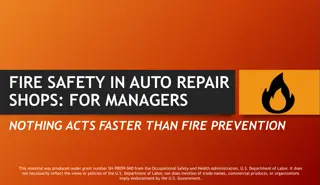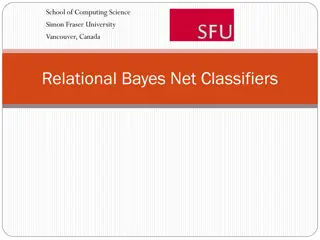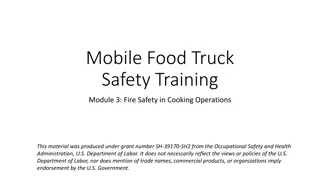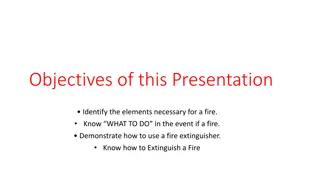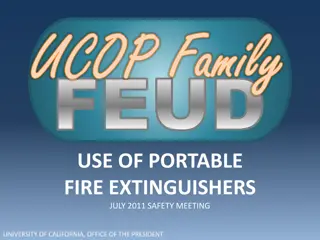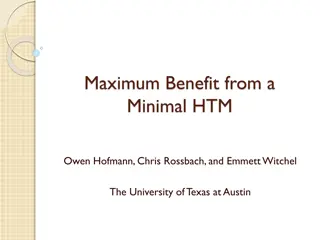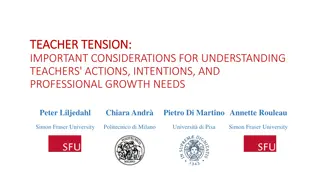Tensions in UK Fire Prevention: Transactional vs. Relational Approaches
Exploring the tensions between transactional and relational approaches in UK fire prevention, this presentation shares insights from a case study at Nottinghamshire Fire and Rescue Service. Seeking feedback on relevant literature, it delves into the NFCC Person-Centred Framework, literature on fire prevention, public services, and more. Methodology involves a qualitative case study with emerging themes highlighting the importance of shared purpose, genuine assistance, and the debate on quality versus quantity in fire prevention efforts.
Download Presentation

Please find below an Image/Link to download the presentation.
The content on the website is provided AS IS for your information and personal use only. It may not be sold, licensed, or shared on other websites without obtaining consent from the author.If you encounter any issues during the download, it is possible that the publisher has removed the file from their server.
You are allowed to download the files provided on this website for personal or commercial use, subject to the condition that they are used lawfully. All files are the property of their respective owners.
The content on the website is provided AS IS for your information and personal use only. It may not be sold, licensed, or shared on other websites without obtaining consent from the author.
E N D
Presentation Transcript
Preventing fires and meeting targets: tensions between transactional and relational approaches to measurement in UK fire prevention Charlotte Pell, PhD candidate Postgraduate Researcher, Centre for Economics, Policy and Public Management at Nottingham Business School at Nottingham Trent University
Purpose of Presentation To explore the tension between a transactional and relational approach to fire prevention To share emerging results from a case study at Nottinghamshire Fire and Rescue Service To ask for feedback from you on further relevant academic literature
NFCC Person Centred Framework Being person-centred means being enabling. The starting point for being enabling is seeing people as assets, not burdens and seeking to support them to recognise, engage with and develop their sense of resourcefulness, and to build on their unique range of capabilities. Being person-centred means offering personalised support. Because we are all different, person-centred support is tailored to the needs and aspirations of each individual, not standardised to their condition or circumstances. Being person-centred means offering coordinated support. It s not just individual encounters that matter services should offer or be part of coordinated support across multiple episodes and over time if needed.
Literature Fire Prevention literature Public services literature with a relational theme Systems thinking literature Literature critical of New Public Management Broader literature on the measurement of public services Literature on public service ethos and public value Public service motivation theory
Methodology A qualitative case study at Nottinghamshire Fire and Rescue (thirty six semi-structured interviews, meeting observation and following the data) Initial literature review of academic, grey and policy literature
Emerging Themes A strong, shared purpose A genuine desire to help people A debate about quality versus quantity Supportive leadership?
A Strong, Shared Purpose think it does come down to the purpose of NFRS is community safety and keeping those at risk safe. It s probably , a clich answer, it s the corporate answer but it is the answer. (INT 15) I suppose morally, we re here to create safer communities, which is our strapline. (INT 56) I suppose there is that strapline of creating a safety community. But it is a strapline but that is what we re about, is making sure people are safe, whether they live here or travel through the county. So it is a strapline, but I think that s what it is. (INT 16)
Helping People and Doing a Good Job it probably sounds really cheesy(!) but it s just keeping the community safe. (INT 19) helping people you know it s now the sort of like ultimate job to be able to do that (INT 47) It s just something that appealed to me, working with the community, you know, saving people s lives basically. (INT 13) And I suppose I joined to make a difference in my community (INT 56) very much led led by improvement. And that s what motivates me. I also if my action is going to have a positive outcome of that improvement and that development, then I m very motivated. (INT 15) What motivates me? Doing a good job. (INT 06)
Quality Versus Quantity so not being numbers driven would help in terms of focusing and targeting resource where it would make most difference (INT 28) that targets can create a problem, certainly when it s number based. Although we have targets for everyone to reach in terms of numbers of safe and wells carried out, in certain areas, particularly in my team, I see it as a problem, because what I don t like to think is that someone s rushed to do a case and put it in a box, and move on to the next one. I would rather them see it through properly and close the loop and all the loose ends to make sure we ve done everything we can do. (INT 15) you don t want performance management just being a stick to beat people with because that s where the chasing of targets comes and the quality decreases. (INT 47) But it s very numbers orientated. So we re very kind of obsessed with how many safe and well visits we ve done, and how many business safety checks we ve done. (INT 42)
Quality Versus Quantity if I wanted a job chasing figures and targets, I d have gone and got a job in a shop as a sales assistant, you know. I don t want to do that, I want to do the job properly and make sure it s done to the best of my ability. (INT 13) Because it s somebody s life, the other side of that and referrals that we can make, they can change that person s wellbeing and day to day life quite quickly, which is great, but we need to keep in mind as a priority that you know these are people and these aren t targets. (INT 19) So you ll always get the behaviours of people going for the path of least resistance and they ll say, well if it s a numbers thing, then we re just going to try target all the low ones and do them as fast as we can and satisfy the numbers. But our core role is to help people and create safer communities and doing that is not doing that. (INT 47)
Supportive leadership? No, we just do what we feel is right, we stick we do three a day. (INT 13) I ve never really been one to be sitting looking at the numbers and going, am I achieving, I just work as hard as I can and the results come anyway (INT 47)
Early Conceptual Framework Data used Type of decision making Reputation-based decision-making Used predominantly by Senior managers and the Fire Authority HMIFRS inspection reports Political capital Performance indicators (largely based on numbers) Benchmarking data Government legislation Consultancy reports Anecdotal data from staff Incident data, demographic data and feedback from service users, person-centred data A strong emphasis on the quality of services to the public What it says on the form/system Targets from their managers What they see and hear on the ground Informal intelligence from colleagues/partners/managers Dynamic/visual data coming from vulnerable people/community. Middle managers Evidence-based decision-making Frontline staff Situation-based decision-making
Initial Findings A clear commitment to purpose Strong public service ethos Support at every level for quality ( doing it properly) Numerical targets talked about as a only a guide Target culture (in this one case study) isn t as I expected (based on studies carried out in UK police and ambulance services) There be may be pressure to chase the numbers in the service, but no one interviewed has said they change what they do to meet targets Person-centred, relational approach appears to be taken in Safe and Well visits Staff know that Safe and Well visits prevent fires and keep people safe, but they don t appear to collect data to measure achievement of this purpose
Questions Raised Is there a targets culture in UK fire and rescue services? How does this compare to other emergency services? If it is different, why? If there is pressure on UK fire and rescue services to chase the numbers , and if so, where is this coming from? What impact is the National Fire Chief Council s Person Centred Framework having on fire prevention practice? What kind of qualitative measures are being used by fire and rescue services (and could be used in the future) to understand whether Safe and Well visits are achieving their purpose, in a way that is truly person-centred?


